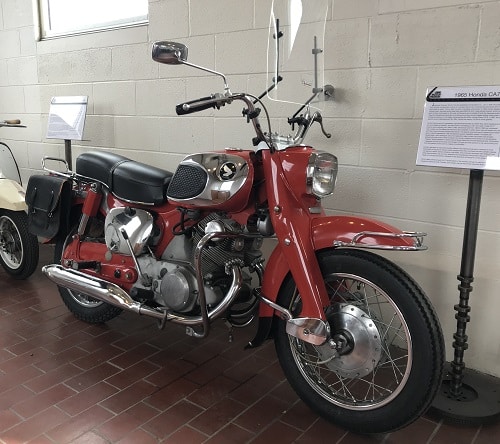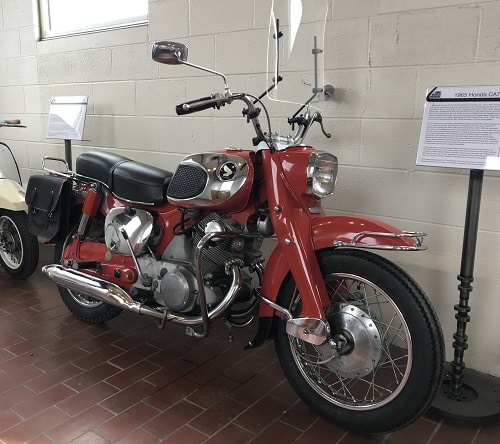
Honda CA77E Dream- 1965

Japanese Engineer Soichiro Honda established Honda Motor Co., Ltd. in 1948. He oversaw Honda’s expansion from cobbling together mopeds from bicycles and generator motors in a wooden shack to the multinational automobile and motorcycle manufacturing company of today. Many of his early bikes he called “Dream” after his vision of building motorcycles. In 1949, Honda released the first “Dream D-Type” motorized bicycle, made of pressed steel—because quality steel pipe was difficult to find. It was painted maroon, which was a stylistic departure from the commonly-seen black paint of other motorcycles on the road, and became an immediate hit with the Japanese public. In 1953, the fuel-efficient, diminutive Honda C-100 Supercub followed and would go on to become one of the world’s biggest selling motorcycles. In September 1959, an American Honda Motor Company storefront in Los Angles introduced the the 305cc Honda Dream CA76. In 1961, the 305cc CA77 with electric starting arrived and became popular almost instantaneously. By 1964, Honda was selling 100,000 a month globally.
Honda Dreams were not necessarily high-performance bikes but rather they were inexpensive to own and reliable to maintain, and they weren’t intimidating to ride. The “early” model CA77 Dreams were produced from 1960 to 1963, while those built from 1963 to 1969 are considered “late” models, but the differences were very few. Available in white, black, blue and scarlet red, and all of them used the same pressed steel frame. The angular lines and sharp creases of the Dream gave it a sturdy appearance. With its distinctive square headlight nacelle—complete with speedometer—and rectangular rear shock absorber upper covers, the Dream was all steel, dressed with side covers. While it looked a bit chunky, elegance could be found in its appealing “Pagoda” styled headstock, molded drop tail fender flares and chrome-sided gas tank. Honda said, “I designed the lines on the side of the Dream C70 gas tank with a picture in my mind of the curve from the eyebrow to the nose on a figure of the Buddha.”
Honda’s approach to motorcycle building offered many features that weren’t common to most motorcycles of the period. Dreams came equipped with alloy overhead-cam twin cylinder engines, 12v electrics, electric starter, indicators, dual seats, and most were equipped with whitewall tires. While these qualities may not have attracted a lot of traditional motorcyclists, they turned the heads of a younger generation interested in the adventure of having fun on two wheels.
Elvis Presley owned a black CA77 Honda Dream in the mid-60’s, though he was known for his Harley-Davidson FLH. He also bought a white Honda Dream for his future bride, Priscilla. Elvis’ Dream may be seen in the collection at Graceland, where it remains on display.
Specifications:
Manufacturer: Honda Motor Company, Ltd
Country of Origin: Japan
Engine: 305cc, two-cylinder, four-stroke, 23hp
Transmission: 4-speed
Top Speed: 86 mph
Years of Production: 1961-1967
Number Produced: About 250,000 of the 250 and 305 variations
Original Cost: About $600
